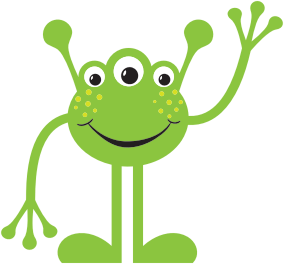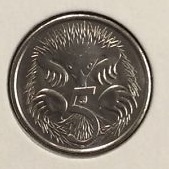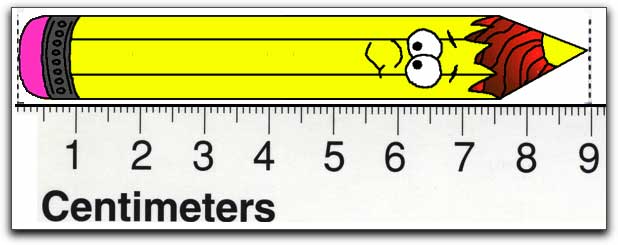Prekinder to Grade 2 Mathematics
Metric Length
Metric Length

This is Blublubox, a friendly alien from the planet BleBeep who is visiting the Earth. He'd like to find out about how Earthlings measure things like heights and distances. These are examples of length measurements.
Well, Blublubox, there are two main systems used for measuring things here on Earth. They are the metric system and the Imperial system (the US standard system is very similar to the Imperial system). In this article, we'll talk about measuring length using the metric system. This is the system that is now officially used in Australia and New Zealand. The childrens' grandparents might still use the Imperial system. You can read about the Imperial system in the article on measuring length in the Imperial system.
Units for Length Measurement in the Metric System
There are many different units used for measuring length in the metric system. The most commonly used ones are:
- Millimetres
- Centimetres
- Metres
- Kilometres
Millimetres

Millimetres are the smallest of the commonly used metric units of length. They are used to measure very small lengths. They are the smallest of the commonly used metric length units. Carpenters often use millimetres when they are designing their furniture. This is because, for example, a very small difference in the lengths of the legs of a chair can cause it to wobble.
Some example measurements in millimetres are:
- A Blu-ray disc is \(1\) millimetre thick.
- The head of a pin (the flat ones in the pin cushion) has a diameter of about \(1\) millimetre.
- A five-cent coin is \(1\) millimetre thick.

- A flea (enlarged in the picture here) is somewhere between \(1 \; \frac{1}{2}\) and \(4\) millimetres long.

Centimetres
The centimetre is the next largest metric unit of length:

Dressmakers often measure lengths in centimetres. We also measure our heights in centimetres.
Some examples of measurements in centimetres are
- A shirt button has a diameter of \(1\) centimetre.
- A \(5\) cent piece has a diameter of about \(2\) centimetres, and a \(20\) cent piece has a diameter of about \(3\) centimetres.
- Your ruler is \(30\) centimetres long.
- This pencil is \(9\) centimetres long

- I am \(165\) centimetres tall. Blublubox is about \(93\) centimetres tall.
Metres
The metre is the next largest metric unit of length:


We measure the heights of buildings and mountains in metres. We also use metres to measure the lengths of running tracks, playgrounds, rooms in houses and short paths.
Some examples of measurements in metres are
- A 4 or 5 year old child is about \(1\) metre tall.
- The door knob on your door at home is \(1\) metre above the floor.
- The shallow end of a swimming pool is around \(1\) metre deep.
- A cricket pitch is about \(20\) metres long and \(3\) metres wide.
- The oval at the MCG is \(171\) metres long.
- A female humpback whale is \(15\)-\(16\) metres long.
- The Sydney Harbour Bridge is \(134\) metres high.
- Uluru is \(348\) metres high.
Kilometres
The kilometre is the largest of the commonly used metric units of length. We use kilometres to measure long distances.

We measure the distances between cities and the lengths of plane journeys in kilometres.
Some examples of measurements in kilometres are
- One kilometre is the distance you can walk in \(12\)-\(15\) minutes.
- The maximum width of Bass Strait is \(350\) kilometres.
- There are \(878\) kilometres between Sydney and Melbourne along the M31.
- The maximum depth of the ocean is about \(11\) kilometres.
- The Great Barrier Reef is \(2,300\) kilometres long.
- The flight from Sydney to Wellington (NZ) is \(2,224\) kilometres long.
Conclusion
So, Blublubox, those are the commonly used metric measurements. You would measure the length of your eyelashes in millimetres, your height in centimetres, the height of your spaceship in metres, and the diameter of the Earth in kilometres.
Description
This mini book covers the core of Math for Foundation, Grade 1 and Grade 2 mathematics including
- Numbers
- Addition
- Subtraction
- Division
- Algebra
- Geometry
- Data
- Estimation
- Probability/Chance
- Measurement
- Time
- Money
- and much more
This material is provided free of cost for Parent looking for some tricks for their Prekinder, Kinder, Prep, Year 1 and Year 2 children
Audience
Grade 1/Year 1, Grade 2/Year 2, Prep, Foundation, Kinder and Pre-Kinder
Learning Objectives
These lessons are for kids aged 4-8 with the core objective to expose their brains to concepts of addition, subtraction, division, algebra and much more.
Author: Subject Coach
Added on: 6th Apr 2018
You must be logged in as Student to ask a Question.
None just yet!